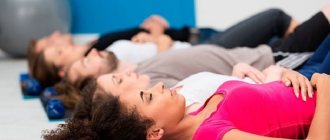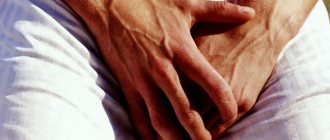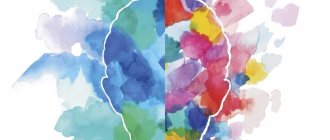Is the use of auto-training indicated for panic attacks?
Panic disorder is not a pathology. The psyche is not always ready for stress, and then the brain seems to save you, blocking the entire bouquet of emotions, thoughts, sensations, then throwing out what has accumulated in the form of symptoms of VSD or, more correctly, panic attacks. With such a disruption of the nervous system, the body is constantly in a state of tension. The body is in combat readiness in the face of danger. The muscles are toned, the head is working intensively, the adrenaline level is off the charts.
The search begins for how to deal with this. And then the first thought is to take some kind of sedative. This is what doctors advise. But the attack repeats...
After some time, a person one way or another learns about the existence of autogenic training (or autotraining) and the possibility of using it to treat panic attacks. Of course, auto-training is a wonderful thing. After all, thanks to it, you train the skill in advance - to manage your nervous system, control your emotions. And this is very important for mastering your state of mind, and therefore for fighting panic attacks.
Preparation for class
Auto-training is a type of hypnosis, so people who have ever attended such sessions know what to do.
- First you need to choose the right time - there is no universal clock. It could be morning, afternoon or evening, night - the main thing is that at the chosen time of day the patient should be calm and relaxed. Most often this is in the morning after waking up, although many people exercise immediately after coming home from work, wanting to relieve the stress that has accumulated during the day.
- It is important that there are no distractions - turn off the ringer on the intercom and telephones, do not turn on the TV or radio. If noise from the street bothers you, it is better to close the window. It is also advisable to conduct the session when there are no children or other family members at home.
- Having chosen the right time, it is important to maintain regular training. Gradually, the body and organism will get used to it, and by the right time they will independently enter the desired state.
- The location of the training is also important - it is good if there is a reclining chair or a rocking chair. You can conduct the session sitting on a chair or lying down. The latter position is risky because a person may fall asleep without completing the procedure. Many perform the session standing or sitting on the floor, with their legs folded in Turkish or in the lotus position, if stretching allows it. The main thing is that there is no feeling of discomfort, otherwise it will be difficult to tune in.
- There should be no bright light in the room where consciousness will take place. If necessary, close the curtains and turn off the lights using, for example, a table lamp.
Having provided these factors, one should move on to preparing the consciousness. If you feel that you won’t be allowed to exercise today, or that the exercise will not give the expected effect, it is better not to start. The main thing is to believe in the methodology and its effectiveness.
How effective is auto-training for panic attacks?
Panic attacks, coupled with a diagnosis of VSD, are a signal that not everything is right in life. The panic syndrome itself is a kind of analogy, a reflection of life’s problems by disturbances in the functioning of the autonomic nervous system. Moreover, where, in what organs, the sympathetic nervous system “shoots”, these are the human complaints. This is where the symptoms of palpitations, high blood pressure, trembling hands and the like come from.
Such people have a great need for internal reorganization. To be adapted to stress, make decisions faster. If you regularly perform auto-training for panic disorder, psychological dead ends are gradually unblocked. The psyche, when it receives enough attention, begins to heal itself []:
- Relaxation reduces impulses from the sympathetic nervous system;
- Gaining access to your resources is empowering;
- Commands and settings change behavior.
Once experienced relaxation during auto-training is an important experience. He is memorable. Subsequently, you take it out of memory, but the reflex remains. I learned to ride a bicycle as a child, and after many years you sit down and ride.
How to get rid of vegetative-vascular dystonia forever at home?
Vegetative-vascular dystonia (VSD) is, in fact, a neurosis accompanied by disruption of the functioning of the autonomic part of the peripheral nervous system and organs whose work is regulated by the autonomic nervous system. To improve the well-being of a patient with VSD, it is necessary first of all to bring his nervous system into a normal state. Let's look at how you can do this at home, without special medications.
Treatment of VSD is always a comprehensive approach, including drug therapy, sessions with a psychotherapist, proper nutrition, physical therapy, and lifestyle changes. That is, of course, it is impossible to cure VSD without qualified medical care, but you can alleviate your condition as much as possible and improve the effectiveness of drug therapy prescribed by your doctor at home, using the following methods:
- Proper nutrition.
- Physical exercise.
- Complete rest.
- Traditional methods.
- Autotraining.
Nutrition for VSD
People suffering from VSD need to eat light foods rich in vitamins, macro- and microelements, and also drink enough fluids. The following foods must be present in your daily diet:
- Chicken meat.
- Calf liver.
- Fish (mackerel, herring, salmon).
- Bananas.
- Fresh tomatoes.
- Cabbage.
- Citrus.
- Greenery.
- Vegetable oil.
- Low-fat dairy products.
- Unpeeled rice.
- Bread with seeds.
- Sprouted wheat.
- Beans.
All these products contain substances that the nervous system needs: fatty acids, B vitamins, ascorbic and folic acid, calcium and magnesium. In addition, you should limit your intake of animal fats and easily digestible sugars. You should also completely avoid alcohol, strong coffee and tea, and carbonated water.
Physical education and VSD
Physical therapy (physical therapy) is an integral part of the treatment of autonomic disorders. A set of correct and safe exercises for exercise therapy can only be selected by a specialist, based on the general condition of the patient and the type of VSD (hypotensive or hypertensive). For example, jumping, fast running and strength training are contraindicated for people prone to hypertension.
- General strengthening exercises. This could be an ordinary morning exercise that affects most of the muscles of the human body.
- Breathing exercises.
- Health swimming.
- Walking in the park or jogging slowly.
In addition, a contrast shower is very useful for autonomic disorders.
Sleep is considered the best medicine for the nervous system, so patients with VSD need to sleep at least 8 hours a day. This condition is mandatory, and even the most modern treatment methods will not help cope with the disease if a person does not have healthy sleep. To make it easier to fall asleep and make your sleep sounder, you should not overeat or drink a lot of liquid in the evening, and also ventilate your bedroom well.
In addition, do not forget about rest. With VSD, it is very important to be able to relax and switch. You cannot exhaust your body with overtime work; in the case of children, you cannot overload them with numerous sections and circles. It is advisable to spend weekends in nature, and annual vacation - in some pleasant place, which can even be a house in the village.
READ MORE: Treatment of neurosis in Chelyabinsk
To ease the well-being of patients with VSD, traditional medicine has a lot of methods. Among them are several of the simplest and most accessible:
- Taking decoctions of plants that have a calming effect. These include motherwort, valerian, mint, lemon balm, St. John's wort, etc.
- Health improvement with folk remedies based on bee products (honey and propolis).
- The use of herbal remedies that have a beneficial effect on the autonomic nervous system. This can be tincture of eleutherococcus, decoctions of lemongrass and ginseng root.
Autotraining
Recently, treatment of VSD using Kurpatov’s method has become very popular. This technique is based on a complete rethinking of one’s condition, overcoming self-doubt, and getting rid of fears of illness, doctors and medical institutions. This can be achieved with the help of a special auto-training program.
Sources used: kardioportal.ru
What is better to use for panic attacks: auto-training or hypnosis sessions? What is their difference?
Autotraining is SELF-hypnosis. In hypnosis, a therapist works with you. It is he who makes it easier for you to immerse yourself in a trance, and comes up with a treatment plan in general, as well as for this particular session. It is he who finds the words to reach your subconscious. Obviously, during autogenic training you do all this yourself.
Therefore, auto-training is a little more complicated than a hypnosis session - because you will have to be in the role of a hypnologist and a client at the same time. However, even if you choose ONLY hypnotherapy, it will not be effective if you do not learn self-hypnosis, and, consequently, self-regulation of your emotional and physical state. A good hypnotherapist will do everything possible to teach you self-hypnosis, particularly AT.
Hypnosis is carried out during a session, and auto-training is more universal - you do it when it’s convenient for you, even on the eve of PA, and you determine the duration of the session yourself.
Advantages
Autotraining is easy to learn - there is nothing complicated in carrying out the method, so no additional skills are needed. Anyone can do auto-training without the help of specialists.
High performance instills confidence in the technique. Accessibility also allows you to do auto-training at home, right in your bed or favorite chair. The ability to quickly master the rules will help you carry out the procedure correctly the first time, receiving relief and faith in the best after the first session.
Auto-training is a natural, absolutely safe and effective way to restore a positive attitude and correct psychological disorders. This method is one of the few that has found application in traditional medicine.
When and how should auto-training be used during panic crises?
The famous “coachman sitting on a droshky pose” is ideal for practicing AT in the office. You can lie down more comfortably at home
Autogenic training can be done whenever and as much as you want. With sufficient persistence, the habit of managing emotions, behavior, and sensations is developed. The more you practice, the better the skill. After a couple of weeks, you may notice how much less anxious you become. And this is already a huge step towards solving the problem.
If insomnia is added to panic attacks, do auto-training before bed. Then your sleep will be deep and even. Or you can do it right during your lunch break, during the day. And recover and benefit.
To perform auto-training, it is better to lie down. If this is not possible, sit comfortably in a chair. To have somewhere to lay your head back and put your hands. Extend your legs straight in front of you. You can close your eyes.
What it is?
Dr. I.G. Schultz first described auto-training in 1932 - he noticed that when hypnotizing patients, many of them independently become calm, become relaxed, and can also fall into a shallow sleep. Today it has already been scientifically proven and confirmed by practice that many diseases can be cured with words, and in case of neuroses and overexcitation, auto-training helps to quickly fall asleep, sleep peacefully, and subsequently absorb stress without experiencing discomfort.
Self-hypnosis has incredible power - Eastern masters who train day and night achieve incredible results. They not only recover from diseases, but control their pulse, can stop the heart, then start it again. Thanks to such evidence, auto-training is in demand by psychologists and psychiatrists and their clients. The technique itself is rarely criticized, since the result is impossible only if the person himself is initially skeptical and does not carry out the procedure seriously.
Autotraining for PA - step-by-step instructions
By relaxing your muscles, you focus your attention on certain sensations. This results in a state similar to hypnosis. And then you pronounce command-phrases containing changes to confidence and calm. This is the essence of AT.
Therefore, we can distinguish the following phases of autogenic training:
- Relaxation.
- Special suggestions. They can be direct - in the form of text, and indirect - suggestions through images, stories.
- Return.
Relaxation.
You say (to yourself):
I'm ready to rest. Gradual relaxation begins. I feel lightness and calm filling me. My body is weightless and relaxed. I feel the warmth pleasantly enveloping me.
I feel the muscles in my right leg relax. The feet relax, then the lower leg, and the thigh muscles. My right leg feels heavy. Now the muscles of the left leg relax. Slow relaxation goes through the muscles of the foot, then the thighs, and moves to the lower leg. My left leg feels heavy. I feel warm. I'm absolutely calm.
Now I feel the muscles of my right arm slowly warming up. Warmth and heaviness moves from the hand to the forearm, then to the shoulder. Now relaxation goes along the left hand. The heat moves from the hand to the forearm, then to the shoulder. My hands are motionless and heavy. I feel at peace.
Now the abdominal muscles relax. Then the back. The neck relaxes.
The head is light.
I feel warmth and lightness enveloping me. I feel good and calm. My body is resting. I feel filled with strength and energy.
Instilling the necessary settings, remembering them in advance.
“Now I'm talking to myself. I look at myself from the outside. It's my time to hit the road. I don't know what awaits me beyond the threshold. I don't know what I'll have to face. But I know that faith in myself, in my inner core will help me and bring me success. Some things still bother me, but I know that anxiety is a fog. And this fog leads to panic. I look at myself and see a fog of anxiety on my face. And now I’m driving this anxiety away from my face. I clear away the fog and gain self-confidence. I feel my inner core. I straighten my back, straighten my shoulders, and thereby banish any remaining anxiety. I see my head rise higher. And I see my confident and calm look. (take a short pause) My body and mind are in harmony, they help each other. Now I feel how calmness has filled me completely. I am ready for any difficulties. And now it's time for me to move forward.
Return
I find myself rested and full of energy. I have a desire to do everything I have in mind. I'm coming back here, to this place where I am now.
I gradually feel my fingers and hands. They can move. The arm muscles tense. I clench my fists and feel the pleasant strength in my hands.
Now I'm straining my feet. I feel firmness in my legs. The back bends upward. There is energy moving throughout my whole body. Now I feel every muscle of my face and lips. They can move. I take a deep breath and hold it for a couple of seconds. Then I exhale through my mouth. And at the same time I unclench my fists and open my eyes. I'm back. There is vigor and inner peace in my body. I can do everything.
You can use this auto-training. Or insert your own commands, settings and words that suit you exclusively. You can learn more about the auto-training technique from books. Our recommendation: read the brochure “Autogenic training for you” by A. Petrov.
Causes and treatment of obsessive-compulsive neurosis
Obsessive-compulsive neurosis is a mental disorder that is accompanied by the emergence of obsessive ideas, burdened thoughts, a state of internal anxiety, as well as unusual actions to reduce this anxiety.
Obsessive neurosis develops due to biological and psychological factors. But each case is individual, and therefore the degree of influence of factors is different. The severity of manifestations is measured using the Yale-Brown scale. If we consider the psychological side of obsessive-compulsive neurosis, then compulsive behavior (which is not rational) may be due to genetic markers.
According to science, obsessive neurosis occurs as a result of metabolic disorders of the hormone of joy - serotonin. Doctors believe that serotonin regulates anxiety levels by binding to nerve cells through receptors. In addition, scientists suggest that the 3rd factor may be ecology, but a genetic connection has not yet been established.
Medicine knows 3 stages of obsessive-compulsive neurosis:
- At stage 1, manifestations of obsessive states can persist for 2-3 months or about 2 years.
- Remitting, which is characterized by a weakening of obsessions and impulses.
- This stage is characterized by a progressive form of the disease. However, complete relief from anxiety and anxious thoughts occurs extremely rarely. Already closer to 40 years, obsessive neurosis with its painful manifestations recedes.
In the 19th century The term “neurosis” gained popularity, which was equated to the patient’s obsessive state. Scientist Jean-Etienne D. Esquirol called this type of disorder the disease of doubt, since patients often hesitated between common sense and complete nonsense.
Neurosis of obsessive thoughts is suffered less often than neurasthenia or hysterical neurosis. But people of both sexes suffer from this disorder equally. Diagnosis is simple: the patient is asked to stretch his arms forward to make sure his fingers are shaking. In addition, with obsessive-compulsive neurosis, revitalization of tendon reflexes, hyperhidrosis of the hands and disturbances in the functioning of the autonomic system are observed.
Among the most characteristic signs of an obsessive state are the following:
- repetitive behavior;
- rituals;
- regular checks of one’s own actions;
- burdened thoughts that become cyclical;
- craving for counting numbers;
- preoccupation with thoughts about religion, fear, intimate details.
Most often, people around the patient suffer from obsessive-compulsive neurosis, simply perplexed by what is happening. However, it should be noted that the patient reproaches himself for illogical and irrational behavior and actions, but is unable to fight the scourge.
People suffering from obsessive-compulsive neurosis and its symptoms behave inappropriately in everyday life; their actions can be described as paranoid. Many patients admitted that they understood the irrationality of their actions, which subsequently leads to a restless state.
Neurosis of obsessive thoughts in most cases manifests itself in people who are perfectionists, pedantic individuals, often obsessing over little things that others would never notice. But it is fixation that becomes the key to igniting a future neurotic state.
Similar symptoms are observed in patients with autism. The disease often affects individuals with a high level of intellectual abilities. Such people are characterized by excessive attention to detail, scrupulous step-by-step planning of further actions, fear of taking a risky step, an increased level of responsibility, as well as indecisiveness and slowness in making important decisions in life.
In addition to all of the above, patients with obsessive-thought neurosis are characterized by all kinds of phobias:
- cancerophobia - fear of the possibility of getting cancer;
- lissophobia - fear of going crazy;
- Cardiophobia - fear of dying from heart disease;
- oxyphobia - fear of sharp objects;
- claustrophobia - fear of closed spaces;
- agoraphobia - fear of open places and premises;
- acrophobia - fear of heights;
- fear of blushing in public.
All of these phobias can be characterized as obsessive-phobic neurosis, which is difficult for a person to fight, since it arises against his wishes. The patient tries in every possible way to resist the awakening fears and desires, but ultimately nothing can be done about it. Fears or phobias can have either an objective basis or arise as a result of illusions and fictitious stories.
People are often afraid of communicating with others, deadly diseases, attacks in broad daylight, lack of money, and lack of jobs. In rare cases, phobias can lead a patient to commit suicide.
What is a phobia or fear? This is primarily a discrepancy between the perceived danger and the real threat. But it must be said that fear exists only in the human mind and is not always an objective phenomenon. The patient is not able to rationally assess the current situation and protect himself from the source of fear.
With obsessive-compulsive neurosis, patients are irritable, get tired quickly, and find it difficult to concentrate on any type of activity. People complain about problems sleeping. Symptoms manifest differently in each patient, but they are united by a depressed mood with a feeling of inferiority in relation to others. In any situation, a patient with neurosis feels hopelessness and desperation.
Neurosis can acquire a chronic form with periodic bursts of exacerbation.
Considering the course of the disease in children, scientists came to the conclusion that the process is reversible, i.e., a violation of the perception of surrounding reality does not occur. Parents often do not pay attention to the child's changed behavior, believing that a fleeting change in mood or behavior is just a prank. Signs of the disease in children:
- periodically repeated movements;
- frowning forehead;
- sniffing;
- shoulder twitching;
- clapping hands;
- stamping.
To this list it is worth adding the feeling of fear that children experience, for example, fear of damaging pieces of furniture, getting their new jacket dirty, or being left in a confined space.
When children become teenagers, the obsessive neurosis itself changes. Teenagers are afraid to speak in front of large crowds of people and suffer from the thought of dying prematurely from illness. Their behavior becomes diametrically opposed. Actions can sometimes be immoral and blasphemous; an obsession can haunt for months.
At the same time, it is impossible to translate all experiences into reality, but the condition itself causes fear and anxiety. In such situations, parents should seek the help of a psychotherapist. Game methods and fairy tale therapy are used to treat obsessive-compulsive neurosis. Of course, the age of the child and the degree of the disease play an important role.
READ MORE: Depression - causes, symptoms and treatment
For some people, it happens that they suddenly want to make the same movements periodically. At the same time, a person critically evaluates his own actions. Such constant movements are called compulsions in medicine. Characteristic signs of compulsions:
- an irresistible desire to perform some action;
- in most cases, patients are aware of the irrationality of behavior, but cannot do anything about it;
- compulsions destroy a person’s life, as irrationality tries to displace the rational principle.
Doctors have not come to an exact definition of the causes of obsessive action neurosis. But most often, obsessive movement neurosis occurs due to the action of psychological factors (psychological trauma), biological (hereditary predisposition, trauma in the family), sociological (strict upbringing based on religious ideas).
In order to decide how to treat, an experienced doctor identifies the form and severity of the disease. Therapy is carried out both comprehensively and individually, based on the characteristics of the patient’s behavior. Mild manifestations of obsessive-compulsive neurosis are treated using psychotherapeutic methods.
Regular training will help you cope with neurosis, which will bring positive results, gradually suppressing obsessive ideas and thoughts. But if a positive effect is not observed, then it is recommended to use hypnotic methods. The patient is prescribed sedatives and tonics depending on the symptoms of obsessive-compulsive neurosis and the stage of the disease.
To cure obsessive-compulsive neurosis at the initial stage, when the patient also suffers from obsessive-phobic neurosis, is necessary with the use of tranquilizers and antidepressants. When selecting a dose of medication, the nature of obsessive-compulsive neurosis is taken into account, and how a person can get rid of the disorder as quickly as possible.
There are severe cases of obsessive-compulsive neurosis, treatment of which at home is not possible, therefore it is treated only in a hospital. For treatment, drugs such as antipsychotics, antidepressants and hypoglycemic doses of insulin are used. The recovery period directly depends on the patient himself, his desire to re-become a part of society and put aside obsessive thoughts or ideas.
Therefore, symptoms and treatment are interrelated in this case. When the patient cannot cope with isolated obsessions (fear of heights, fear of the dark, claustrophobia), it is necessary to resort to the method of self-hypnosis. The protracted course of obsessive-compulsive neurosis is a reason for transferring such an employee to an easier job. Possible complications may cause such a patient to be assigned disability.
Autogenic training in everyday life
For many people, it is easier to master autogenic training than to use it regularly in the future. This happens, as a rule, because it is difficult for us to refuse the temptation to solve our problems quickly and not to be discouraged by failures. Remember that there are no unsuccessful activities, any activity brings benefits. For example, you couldn’t concentrate on the introductory “Relaxation” exercise; “some nonsense was creeping into your head.” But notice that this “nonsense” distracted you from what was bothering you before the lesson, which you could not achieve in other ways. It doesn’t matter if you learn AT slower than others, because once you master it, you will gain a skill for life!
Try to organically “fit” autogenic training into your daily life. Remember that active reluctance to engage in AT occurs if there is no need for rest. “Catch” the moments when fatigue begins to accumulate, and the activity will be desirable. On the other hand, do not bring yourself to the point of overwork, when the activity becomes impossible due to deterioration in the ability to concentrate.
And, most importantly, remind yourself more often that the autogenic state is not something inaccessible, that it arises by itself in everyone who creates the conditions for its occurrence.
Symptoms of anxiety-depressive disorder
The anxiety that arises with this disorder is unfounded. It is not limited to any specific situation and is not directly related to stress. Her clinical and depressive symptoms are mild. They appear relatively uniformly, and are accompanied by at least several autonomic symptoms: tachycardia and bradycardia, chills, abdominal pain, shortness of breath, sweating, tremor, headaches and dizziness, bowel and urination disorders, muscle tension and pain [2][3] [5].
The DSM-V (Diagnostic Manual of Mental Disorders) defines anxiety-depressive disorder as a chronic or recurrent mood disorder in which features of dysphoria (painfully low mood) and at least four of the following symptoms are observed for a month or more: [eleven]
- difficulty concentrating;
- sleep disturbance (problems falling asleep, feeling drowsy during the day, restless sleep that does not bring rest);
- feeling weak or losing energy;
- nervousness;
- anxiety;
- tearfulness;
- tendency to be overly apprehensive;
- expectation that something bad will happen;
- hopelessness (deep pessimism about the future);
- low self-esteem, self-deprecation.
Also, with anxiety-depressive disorder, significant clinical distress (excessive tension) and/or impairment in social, professional or other important areas of life may be observed [12].
Specific clinical symptoms of the disease appear quite rarely. Nonspecific multisystem autonomic disorders often come to the fore - tachycardia, hyperventilation syndrome (problems with breathing control, a feeling of lack of air against the background of increasing anxiety), functional dyspepsia (digestive disorders not associated with diseases of the internal organs), etc. They significantly complicate the diagnosis of the disease and increase the appeal of such people to doctors who treat somatic (physical) diseases.
During a detailed survey, people with anxiety-depressive disorder complain of low mood, apathy and anxiety. Some patients claim that they are “tired of everything,” “no strength,” although they speak quite cheerfully and verbosely about their problems [2].
Without identifying somatic pathology, therapists, as a rule, make a diagnosis of “neurocirculatory dystonia” (or vegetative-vascular dystonia) and, as a result, prescribe the wrong treatment. Only 1/3 of patients with anxiety-depressive disorder reach psychiatrists and psychotherapists.











